The simplest approach to estimating $$IAM_B\left (\theta_{AOI} \right)$$ was developed by Souka and Safat (1966) and later adopted by the American Society of Heating, Refrigeration, and Air Conditioning (ASHRAE), and is known as the “ASHRAE incidence modifier.”
$$IAM_B= 1-b_{0} \left (\frac{1}{\cos \left (\theta_{AOI} \right)} -1\right)$$
This function has the benefit of needing only one parameter, $$b_0$$ , but suffers from a discontinuity at $$\theta_{AOI}=90^{\circ}$$ and low accuracy at high incident angles. Some authors suggest not applying this function for incident angles where $$\theta_{AOI} \gt 80^{\circ}$$ (Abella et al., 2003). Figure 1 compares ASHRAE model results for two values of $$b_0$$ .

Figure 1. IAM Model Results for the ASHRAE model.
References
[1] Souka A.F., Safwat H.H., “Determination of the optimum orientations for the double exposure flat-plate collector and its reflections”. Solar Energy vol .10, pp 170-174. 1966.
[2] M. A. Abella, E. Lorenzo and F. Chenlo, “Effective irradiance estimation for PV applications,” Proceedings of 3rd World Conference on Photovoltaic Energy Conversion, 2003. Osaka, Japan, 2003, pp. 2085-2089 Vol.2.